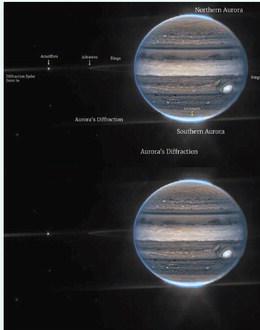Over 370 million miles from planet Earth, Jupiter is the fifth planet in the solar system. It is a gas planet that has a mass more than two-and-a-half times that of all other planets in the solar system combined. Thanks to the engineers and scientists at NASA, there are new images and information about the planet. “We hadn’t really expected it to be this good, to be honest,” said planetary astronomer Imke de Pater, professor emerita of the University of California, Berkeley. Pater is a lead researcher working in the James Webb Space Telescope Saturn research agency, “It’s really remarkable that we can see details on Jupiter together with its rings, tiny satellites, and even galaxies in one image,” she said.
The new photos released by NASA show Saturn, a view of its thin rings, and streaks of light reflecting off of the planet. In elementary school, students are taught that Jupiter has a bright red spot where a massive storm is raging, in the new photos released by NASA the spot, and several other parts of the planet, appear white. According to NASA’s Heidi Hammel, Webb interdisciplinary scientist for solar system observations, the spot appears white because the storm clouds are reflecting a large amount of sunlight. Most of the bright white spots in the new images are believed to be caused by highly elevated storm clouds. “The numerous bright white ‘spots’ and ‘streaks’ are likely very high-altitude cloud tops of condensed convective storms,” Hammel said. The darker areas have little to no cloud coverage. In the images of Jupiter, viewers will notice the glow of the planet’s northern and southern auroras. Earth also has an aurora in the north of the planet, called the Aurora Borealis – also known as the Northern Lights – which has similar effects on both planets, according to a press release from NASA.
According to a press release from NASA, getting these images takes a significant amount of work. “Data from telescopes like Webb doesn’t arrive on Earth neatly packaged. Instead, it contains information about the brightness of the light on Webb’s detectors. This information arrives at the Space Telescope Science Institute (STScI), Webb’s mission and science operations center, as raw data. STScI processes the data into calibrated files for scientific analysis and delivers it to the Mikulski Archive for Space Telescopes for dissemination. Scientists then translate that information into images like these during the course of their research. While a team at STScI formally processes Webb images for official release, non-professional astronomers known as citizen scientists often dive into the public data archive to retrieve and process images, too.”
What is the James Webb Telescope? The James Webb Telescope is a marvel of engineering, and can take such clear photos of star clusters hundreds of millions of light-years away thanks to its Mid-Infrared Instrument, known as MIRI. This instrument can peer through the darkness of space to capture crisp images, the clearest ever seen, of galaxies, stars and other galactic wonders. The James Webb Telescope has a Near-Infrared Camera, which is the telescope’s primarily imager. This camera has the ability to pierce observable light to capture photos of stars which are typically hidden behind the observable light. “The James Webb Space Telescope is the world's premier space science observatory. Webb will solve mysteries in our solar system, look beyond to distant worlds around other stars, and probe the mysterious structures and origins of our universe and our place in it. Webb is an international program led by NASA with its partners, ESA (European Space Agency) and the Canadian Space Agency,” said Laura Betz with the Goddard Space Flight Center in Greenbelt, Maryland.
NASA’s James Webb Telescope captured this photo of Saturn using two filters, orange and cyan. This photo shows the planet’s massive aurora on both the north and south pole. This image was taken by using two tools, a Near-Infrared Camera and a Mid-Infrared Instrument.
Courtesy NASA and Judy Schmidt


